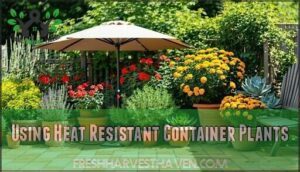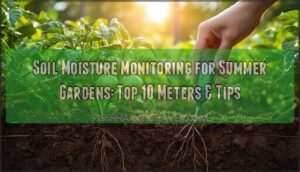This site is supported by our readers. We may earn a commission, at no cost to you, if you purchase through links.
 When you’re learning how to protect plants summer, think of yourself as their personal bodyguard against the heat.
When you’re learning how to protect plants summer, think of yourself as their personal bodyguard against the heat.
Start with shade cloth or natural barriers to block harsh sun rays. Water deeply in early morning when temperatures are cooler, giving roots time to absorb moisture before the day heats up.
Apply a thick layer of mulch around plants to keep soil cool and retain water. Choose heat-tolerant varieties that won’t wilt at the first sign of temperature stress.
Monitor your plants daily for signs of heat damage like drooping leaves or brown edges. The secret lies in combining these strategies effectively.
Table Of Contents
Key Takeaways
- Create shade protection early – Set up shade cloth (30-50% density) or natural barriers like tall plants before heat waves hit, positioning them 12-18 inches above your plants for proper air circulation.
- Water deeply in the morning – Give your plants a thorough drink between 5-9am when temperatures are cooler, allowing roots to absorb moisture before the day heats up and reducing evaporation loss.
- Apply thick organic mulch – Spread 2-3 inches of wood chips or shredded leaves around plant bases to keep soil cool, retain moisture, and create a protective barrier against temperature extremes.
- Choose heat-tolerant varieties – Select native plants and drought-resistant herbs like rosemary, thyme, and oregano that naturally thrive in high temperatures rather than just surviving them.
Protecting Plants Summer
When summer heat threatens your garden, you’ll need proven shade strategies that work when temperatures soar above 86°F.
You can protect your plants using shade cloth, natural barriers, and smart structures that reduce soil temperature by up to 10 degrees and prevent costly heat damage.
Using Shade Cloth Effectively
Beyond traditional garden umbrellas, shade cloth offers your plants reliable sun protection during scorching summer days.
Choose 30-50% shade cloth density for most vegetables and flowers, while delicate seedlings need higher coverage. Understanding specific shade percentages is key to protecting different plants.
- Install using stakes to prevent fabric from touching plant leaves
- Select woven polyester or polyethylene for durability and breathability
- Position cloth 12-18 inches above plants for proper air circulation
- Replace worn sections annually to maintain effective plant shading
Creating Natural Shade Barriers
You can harness nature’s own cooling system by strategically positioning plants for maximum shade benefits.
Tall crop shading works brilliantly—plant corn or sunflowers to shelter heat-sensitive vegetables below.
Fast-growing trees provide excellent overhead protection, while vining plant walls on A-frame structures create airflow corridors.
Living mulch shade from groundcovers keeps soil cool and roots protected naturally, utilizing nature’s own cooling system.
Setting Up Shade Structures
Permanent shade structures transform your garden into a heat refuge that’ll save your plants year after year.
Smart pergola placement near vulnerable crops creates lasting protection, while sturdy trellis designs support climbing vines that double as natural canopies. Shade cloth can offer UV protection.
- Awning materials like canvas or shade cloth offer adjustable protection
- Temporary shade solutions include pop-up canopies for quick relief
- Garden shade from pergolas works best in sunny, open areas
- Plant shelters using A-frame structures provide targeted coverage
- Natural canopies from trees create long-term cooling zones
How to Protect Plants Summer
Summer heat can turn your green oasis into a wilted disaster faster than you can say "heat wave." Your plants don’t have to suffer through another scorching season when you know the right summer plant care strategies.
Protecting plants from heat requires a multi-layered approach that addresses their most vulnerable points during extreme temperatures.
Here’s your essential heatwave plant rescue toolkit:
- Create immediate shade barriers using cloth or temporary structures to block harsh afternoon sun
- Establish proper watering best practices with deep, early morning irrigation sessions
- Monitor heat stress plants for warning signs like wilting, leaf burn, or flower drop
- Implement shade gardening tips by positioning vulnerable plants near taller companions
These soil cooling methods and protective strategies work together to shield your garden from temperature extremes. When you combine smart positioning with consistent care, your plants will thrive despite the mercury rising.
Managing Soil and Moisture
Your soil holds the key to keeping plants cool and hydrated during scorching summer days.
You’ll need to master mulching, watering techniques, and moisture monitoring to create an underground defense system that protects roots from heat stress.
Applying Mulch for Temperature Control
Why wait until noon when morning mulch application delivers maximum cooling benefits?
Apply organic mulch like wood chips or shredded leaves 2-3 inches thick around plant bases for ideal soil insulation. This mulch thickness prevents overheating while maintaining essential nutrients.
Create your plant’s personal cooling system with thick organic mulch that works around the clock.
Consider different mulch options for your garden.
Smart mulch timing—before temperatures spike—creates a protective barrier that keeps soil temperature stable, supporting healthy summer soil health throughout scorching days, which is crucial for healthy summer soil health and overall plant well-being with stable soil temperature.
Conserving Moisture With Groundcovers
Beyond traditional mulching, groundcovers act as living mulch that dramatically improves water retention while reducing soil evaporation by up to 70%.
Choose drought tolerant plants for groundcover selection, creating natural root shade that maintains soil moisture year-round.
These living carpets enhance soil health better than static materials, providing continuous protection that adapts with your garden’s changing needs.
Mulching also substantially helps to reduce soil water loss by decreasing evaporation.
Watering Techniques for Heat Stress
When plants wilt during scorching days, proper watering techniques can mean the difference between thriving gardens and crispy casualties.
Deep watering early morning between 5-9am maximizes root hydration while minimizing evaporation reduction. These timing strategies guarantee consistent moisture reaches where it’s needed most.
A good strategy is to evaluate drip irrigation methods for efficient water use.
- Drip irrigation delivers water directly to root zones for maximum efficiency
- Morning watering prevents fungal diseases while optimizing plant hydration absorption
- Slow, deep applications encourage drought-resistant root development below surface
- Direct soil watering avoids leaf scorch from water droplets during heat stress
Monitoring Soil Moisture Levels
Guessing when your plants need water is like playing roulette with their lives.
Soil moisture meters take the guesswork out of watering summer plants by measuring moisture levels 6-8 inches deep where plant roots actually live.
Check readings twice weekly to establish deep watering frequency patterns.
Visual soil assessment helps too—dry, cracked soil signals immediate attention needed, which can be determined by checking the soil moisture levels to prevent playing roulette with their lives.
Selecting Heat Tolerant Plants
You can’t change the weather, but you can choose plants that actually enjoy the heat instead of just surviving it.
Smart plant selection means picking varieties that thrive in high temperatures, saving you time and effort while keeping your garden looking great all summer long, which is a result of smart plant selection.
Choosing Native Plant Varieties
Smart gardeners often discover that native plants are nature’s ultimate heat-resistant plants, perfectly adapted to local ecosystems and climate conditions.
These drought champions support soil health while requiring minimal water conservation efforts.
Here’s why native varieties excel during extreme heat:
- Deep root systems access groundwater during drought periods
- Natural pollinator support attracts beneficial insects year-round
- Superior climate adaptation handles temperature swings effortlessly
- Enhanced plant hardiness survives without constant intervention
Planting in Optimal Sunlight Locations
Location matters more than you think.
Watch how sunlight moves across your yard throughout the day—morning sun with afternoon shade works best for most plants.
Vulnerable plants need protection from intense sunlight after 2 PM.
Position containers where you can easily move them when heat spikes.
East-facing spots offer gentle morning light without the brutal afternoon burn.
Using Heat Resistant Container Plants
Beyond traditional garden beds, container gardening offers flexibility during summer heat waves.
Choose heat-tolerant plants like geraniums, marigolds, and succulents for your containers.
These container varieties thrive in quality potting soil with proper drainage.
Strategic plant placement in morning sun locations reduces afternoon heat stress.
Remember that mulch reduces soil temperature in container gardens, helping to retain moisture.
Monitor watering needs closely, as containers dry faster than ground plantings during hot weather, requiring proper care.
Selecting Drought Resistant Herbs
Mediterranean herbs are your garden’s superheroes against summer heat.
These drought-resistant champions thrive when temperatures soar and rain disappears. Choose heat-tolerant plants that match your herb sunlight needs while considering soil drainage importance.
- Rosemary – thrives in poor, well-draining soil
- Thyme – perfect for companion herb planting with vegetables
- Oregano – requires minimal watering herb frequency
- Sage – excellent for harvesting drought herbs repeatedly
- Lavender – natural pest deterrent with gorgeous blooms
Mitigating Heat Stress Damage
When heat stress hits your plants, you’ll notice wilted leaves, dropped flowers, and stunted growth that signals your garden needs immediate help.
Quick action to identify these warning signs and adjust your care routine can save stressed plants and prevent further damage during extreme temperatures.
Identifying Symptoms of Heat Stress
Heat stress shows up fast when temperatures soar.
Watch for sunburned leaves with brown, crispy edges and wilted foliage that won’t perk up after watering.
You’ll notice stunted growth, flower drop, and fruit falling off prematurely.
Rapid drying soil signals trouble too, and these plant symptoms mean your garden’s crying for help before permanent damage sets in, indicating a need for immediate action.
Providing Proper Nutrition for Heat Resistance
Well-fed plants handle summer heat like athletes with proper training.
Apply balanced fertilizer 2-3 days before heat waves to boost heat resistance by 40%.
Focus on slow-release options that won’t burn roots during hot weather.
Kelp extracts and biostimulants enhance nutrient uptake efficiency by 25%, while calcium prevents blossom end rot in stressed vegetables, which can be critical for maintaining overall nutrient uptake.
Maintaining Healthy Soil Composition
Your soil’s foundation determines how well plants handle summer’s punishing heat.
Soil amendments like compost boost microbial activity while improving nutrient balance and drainage improvement.
Add organic material through mulching to strengthen root systems and support healthy watering patterns.
Well-draining soil with active microbes helps plants access nutrients efficiently, creating natural erosion control that keeps your garden thriving during scorching temperatures with healthy watering patterns.
Utilizing Climate Considerations for Plant Protection
Smart gardeners check their Hardiness Zones and historical data before summer hits.
Understanding your local climate patterns helps you prepare better protection strategies for extreme heat events. Mulching helps retain moisture and regulate soil temperature.
- Research temperature trends – Use weather archives to identify peak heat periods and plan accordingly
- Monitor sunlight exposure patterns – Track daily sun movement to optimize plant placement and shade timing
- Study plant pathogens cycles – Warmer conditions increase disease pressure, requiring preventive measures
- Assess heat tolerance zones – Match your plants’ capabilities with expected temperature ranges for success
Frequently Asked Questions (FAQs)
When should I move outdoor plants indoors?
You should move outdoor plants indoors when nighttime temperatures consistently drop below 50°F.
Or before your area’s first expected frost date.
Check local weather forecasts and bring tender plants inside gradually.
How do I protect seedlings from heat?
Though seedlings seem fragile, they’re tougher than you’d think.
Use shade cloth, apply mulch around bases, water early morning, and move containers to spots with morning sun but afternoon shade protection.
Can I use fans to cool plants?
Yes, you can use fans to cool plants effectively.
Position oscillating fans to create gentle air circulation around your garden.
This reduces ambient temperature, increases evaporation for natural cooling, and prevents stagnant hot air pockets, which is a key concept for natural cooling.
What fertilizers help plants survive extreme heat?
Like giving plants vitamins during illness, balanced fertilizers with lower nitrogen help them survive heat.
You’ll want potassium-rich options to strengthen cell walls and phosphorus for root health during stressful summer conditions.
How do I revive heat-damaged plants?
Gradually move heat-damaged plants to shade and water deeply at soil level.
Trim wilted leaves, apply mulch, and wait patiently.
Don’t fertilize stressed plants—they’ll recover naturally with consistent moisture and protection.
Conclusion
Armed with these proven strategies, you’re now equipped to be your garden’s summer guardian.
Remember, learning how to protect plants summer isn’t just about surviving the heat—it’s about helping them thrive.
Combine shade protection, proper watering, mulching, and heat-tolerant varieties for best results.
Watch your plants closely for stress signals and adjust your approach as needed, with consistent care and these techniques, your garden will flourish even during the hottest months ahead, becoming a true summer guardian.
- https://eos.com/blog/heat-stress-in-plants/
- https://www.epa.gov/watersense/when-its-hot
- https://www.researchgate.net/publication/376851142_Review_of_Temperature_Management_Strategies_and_Techniques_in_the_Greenhouse_Microenvironment
- https://pmc.ncbi.nlm.nih.gov/articles/PMC3676804/
- https://www.sciencedirect.com/science/article/abs/pii/S0168945219315705












